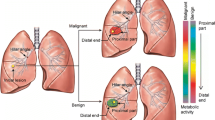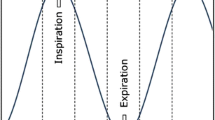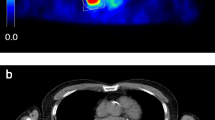Abstract.
The purpose of this study was to determine the actual standardized uptake value (SUV) by using the lesion size from computer tomography (CT) scan to correct for resolution and partial volume effects in positron emission tomography (PET) imaging. This retrospective study included 47 patients with lung lesions seen on CT scan whose diagnoses were confirmed by biopsy or by follow up CT scan when the PET result was considered negative for malignancy. Each lesion's FDG uptake was quantified by the SUV using two methods: by measuring the maximum voxel SUV (maxSUV) and by using the lesion's size on CT to calculate the actual SUV (corSUV). Among small lesions (2.0 cm or smaller on CT scan), ten were benign and 17 were malignant. The average maxSUV was 1.43±0.77 and 3.02±1.74 for benign and malignant lesions respectively. When using an SUV of 2.0 as the cutoff to differentiate benignity and malignancy, the sensitivity, specificity, and accuracy were 65%, 70%, and 67% respectively. When an SUV of 2.5 was used for cutoff, the sensitivity, specificity, and accuracy were 47%, 80%, and 59% respectively. The average corSUV was 1.65±1.09 and 5.28±2.71 for benign and malignant lesions respectively. Whether an SUV of either 2.0 or 2.5 was used for cutoff, the sensitivity, specificity, and accuracy remained 94%, 70%, and 85% respectively. The only malignant lesion that was falsely considered benign with both methods was a bronchioalveolar carcinoma which did not reveal any elevated uptake of fluorine-18 fluorodeoxyglucose (FDG). Of the large lesions (more than 2.0 cm and less than 6.0 cm), one was benign and 19 were malignant and the corSUV technique did not significantly change the accuracy. It is concluded that measuring the SUV by using the CT size to correct for resolution and partial volume effects offers potential value in differentiating malignant from benign lesions in this population. This approach appears to improve the accuracy of FDG-PET for optimal characterization of small lung nodules.
Similar content being viewed by others
Author information
Authors and Affiliations
Additional information
Received 28 April and in revised form 25 May 2002
Electronic Publication
Rights and permissions
About this article
Cite this article
Hickeson, M., Yun, M., Matthies, A. et al. Use of a corrected standardized uptake value based on the lesion size on CT permits accurate characterization of lung nodules on FDG-PET. Eur J Nucl Med 29, 1639–1647 (2002). https://doi.org/10.1007/s00259-002-0924-0
Issue Date:
DOI: https://doi.org/10.1007/s00259-002-0924-0




